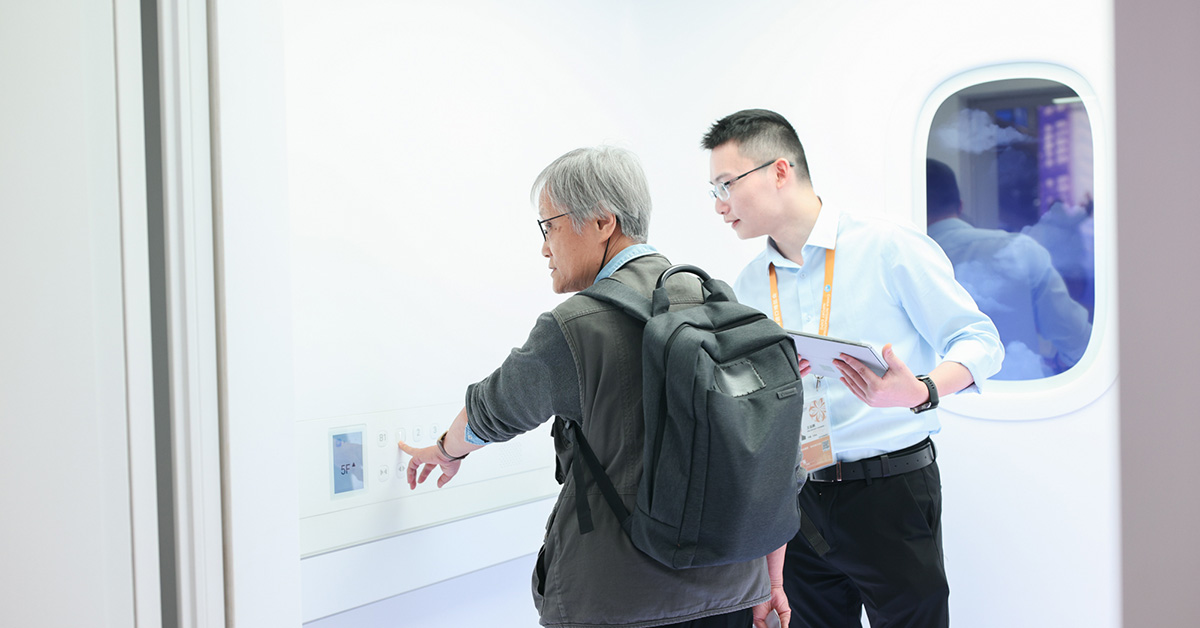Otis Smart Cab Elevator
Otis Smart Cab elevator is much more than smart
- May 28, 2024

Have you ever seen a concept car at an auto show – one designed with innovative features to create customer excitement about the future?
At Otis, we’re also focusing on exciting ideas and designs for elevator cars, also known as cabs, that are new to the industry – and exploring how to bring them to life for our customers.
The Otis Shanghai Lead Design Center (LDC) development recently unveiled the Otis Smart Cab elevator at the China International Import Expo (CIIE). Crowds of people had the opportunity to see and enjoy a unique experience leveraging the newest in-cabin technology displays, features and aesthetics to enhance elevator rides by offering extensive personalization and sensory experiences.
What is our Smart Cab elevator?
Our Smart Cab concept is immersive and versatile, with Internet of Things connections. Its human-centric, minimalist design features streamlined call and destination buttons, optimized button placement and a smart image display. Tailored lighting and sensory settings provide a holistic, inviting experience that can even include various fragrances, and the cab expands energy-savings by dimming lights and displays as soon as passengers exit.
Where did the ideas originate?
Just as automobiles and smart living amenities become more innovative and intelligent, so too must elevators meet the needs of modern living and future smart cities. This includes demand for more personalized and advanced passenger experiences, allowing people to move comfortably – and reducing accessibility barriers.
Similar to airplanes, elevators are tight spaces that change elevation. On the elevator wall of our Smart Cab is a display that looks like an airplane porthole window, giving the appearance of an outdoor view. Additionally, the white color and lighting – also like the interior of an airplane – reflect a high-tech look.
Exciting design elements
Accessibility. Cabin buttons for choosing a destination floor are on a vertical panel next to the door and on a horizontal panel placed lower on a side wall. This height is more accessible for the elderly, and/or anyone using a wheelchair or experiencing other mobility difficulties.
Cabin color can be changed, often to the Otis brand colors of blue and sunrise pink or others. Door and alarm button colors can represent different functions – and can offer better accessibility for people with visual and hearing impairments.
Comfort. Full consideration is given to ergonomics. Woven together with aesthetics and technology, the cabin’s shape and lines create a more comfortable space for passengers. Additionally, nature sounds are also available to provide a more relaxing ride.
Smooth stone, or “pebbles.” Also to create a safe and comfortable elevator environment, some design elements are based on the warm texture and shape of stones. The appearance of all features – ceiling lights, weather screen, elevator buttons and others, bring a rounded style. Combined with an option for artificial stone materials on the cabin wall, this will promote an overall feeling of calmness, comfort and reliability.
Interacting with passengers. The Smart Cab includes a digital elevator assistant named Little Otis – an animated mascot who communicates with passengers, much like a robot would. It goes beyond a conventional product that would use only text or audio. Little Otis brings a human element to our existing features by providing passengers with helpful information such as basic elevator position and destination and transmits that through use of an animated emoji that changes expressions. With this feature, we hope to make our elevators more user-friendly and to delight passengers through greetings and proactive services.
Energy conservation. Managing energy use is important to customers, and Smart Cab includes opportunities for building owners to choose ways to conserve. During non-peak hours, for example, adjustments can be made for lighting, temperature, and the working modes of other hardware through digital connections.
Remote technology. The built-in Otis ONE™ IoT platform performs proactive monitoring of elevator status to allow for fast service and a high-quality experience for passengers. For example, our Smart Cab innovatively uses millimeter wave radar, which detects passengers waiting to enter the cab. At that point, the elevator will shift from energy-saving sleep mode into wake-up operation.
Passenger alerts. Information such as elevator arrival, passenger capacity and operating status is shared proactively through an interface design in an eye-catching way.
Cabin capacity. Smart Cab’s intelligent design senses the operating status of the elevator and the flow of people. Artificial intelligence cameras can identify and display the types of passengers – for example scooters, pets or crowds.
Just as Otis has delivered breakthrough innovations for more than 170 years, the Smart Cab is the latest to demonstrate the vision of our engineers to bring advanced technology, speed, comfort and safety to our customers.
While Smart Cab features could later be sold as a complete bundle to customers, the model unit is currently used to demonstrate all possibilities. We are working to progressively include some of the most desirable features in our standard product offerings, such as the Gen360™ connected elevator and SkyRise®.
Some Smart Cab features will be available widely in China in 2025, and other features are available through special contracts now in China. In the future, the experience can be further adaptable to meet the growing and diverse needs of our customers.
